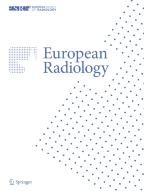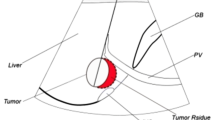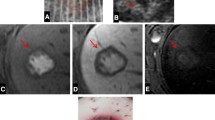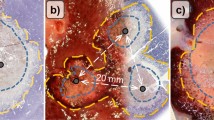Large-volume multi-tined expandable RF ablation in pig livers: comparison of 2D and volumetric measurements of the ablation zone

To compare two-dimensional (2D) and three-dimensional (3D) computed tomography (CT) measurements of ablation zones (AZs) related to the shaft of two different large-volume monopolar multi-tined expandable electrodes.
Methods
Percutaneous radiofrequency (RF) ablation was performed in 12 pigs (81.6 ± 7.8 kg) using two electrodes (LeVeen 5 cm, Rita XL 5 cm; n = 6 in each group). Contrast-enhanced CT with the electrode shaft in place evaluated the AZ. The largest sphere centred on the electrode shaft within the AZ was calculated (1) based on the 2D axial CT image in the plane of the shaft assuming rotational symmetry of the AZ and (2) using prototype software and the 3D volume data of the AZ measured with CT.
Results
The mean largest diameter of a sphere centred on the electrode shaft was always smaller using the 3D data of the AZ than using 2D CT measurements assuming rotational symmetry of the AZ (3D vs 2D): LeVeen 18.2 ± 4.8 mm; 24.5 ± 3.1 mm; p = 0.001; Rita XL 20.0 ± 3.7 mm; 28.8 ± 4.9 mm; p = 0.0002. All AZ showed indentations around the tines.
Conclusions
Two-dimensional CT measurements assuming rotational symmetry of the AZ overestimate the largest ablated sphere centred on the electrode shaft compared with 3D CT measurements.
This is a preview of subscription content, log in via an institution to check access.
Access this article
Subscribe and save
Springer+ Basic
€32.70 /Month
- Get 10 units per month
- Download Article/Chapter or eBook
- 1 Unit = 1 Article or 1 Chapter
- Cancel anytime
Buy Now
Price includes VAT (France)
Instant access to the full article PDF.
Rent this article via DeepDyve
Similar content being viewed by others

The Role of a Curved Electrode with Controllable Direction in the Radiofrequency Ablation of Liver Tumors Behind Large Vessels
Article 13 February 2019

Robotically Assisted Sonic Therapy (RAST) for Noninvasive Hepatic Ablation in a Porcine Model: Mitigation of Body Wall Damage with a Modified Pulse Sequence
Article 30 April 2019

Influence of interapplicator distance on multibipolar radiofrequency ablation during physiological and interrupted liver perfusion in an in vivo porcine model
Article Open access 01 October 2020
Explore related subjects
References
- Elias D, Baton O, Sideris L et al (2004) Local recurrences after intraoperative radiofrequency ablation of liver metastases: a comparative study with anatomic and wedge resections. Ann Surg Oncol 11:500–505 ArticlePubMedGoogle Scholar
- Lencioni R, Crocetti L, Cioni D et al (2004) Percutaneous radiofrequency ablation of hepatic colorectal metastases: technique, indications, results, and new promises. Invest Radiol 11:689–697 ArticleGoogle Scholar
- Mazzaferro V, Battiston C, Perrone S et al (2004) Radiofrequency ablation of small hepatocellular carcinoma in cirrhotic patients awaiting liver transplantation: a prospective study. Ann Surg 240:900–909 ArticlePubMedGoogle Scholar
- Berber E, Pelley R, Siperstein AE (2005) Predictors of survival after radiofrequency thermal ablation of colorectal cancer metastases to the liver: a prospective study. J Clin Oncol 23:1358–1364 ArticlePubMedGoogle Scholar
- Lencioni RA, Allgaier HP, Cioni D et al (2003) Small hepatocellular carcinoma in cirrhosis: randomized comparison of radio-frequency thermal ablation versus percutaneous ethanol injection. Radiology 228:235–240 ArticlePubMedGoogle Scholar
- de Baere T, Deschamps F, Briggs P et al (2008) Hepatic malignancies: percutaneous radiofrequency ablation during percutaneous portal or hepatic vein occlusion. Radiology 248:1056–1066 ArticlePubMedGoogle Scholar
- Stippel D, Brochhagen HG, Arenja M et al (2004) Variability of size and shape of necrosis induced by radiofrequency ablation in human livers: a volumetric evaluation. Ann Surg Oncol 11:420–425 ArticlePubMedGoogle Scholar
- Pitton MB, Herber S, Raab P et al (2003) Percutaneous radiofrequency ablation of liver tumors using the LeVeen 4 cm array probe. Rofo 175:1525–1531 CASPubMedGoogle Scholar
- Frericks BB, Ritz JP, Roggan A et al (2005) Multipolar radiofrequency ablation of hepatic tumors: initial experience. Radiology 237:1056–1062 ArticlePubMedGoogle Scholar
- Lee JM, Han JK, Lee JY et al (2006) Hepatic radiofrequency ablation using multiple probes: ex vivo and in vivo comparative studies of monopolar versus multipolar modes. Korean J Radiol 7:106–117 ArticlePubMedGoogle Scholar
- Bangard C, Gossmann A, Kasper HU et al (2006) Experimental radiofrequency ablation near the portal and the hepatic veins in pigs: differences in efficacy of a monopolar ablation system. J Surg Res 135:113–119 ArticlePubMedGoogle Scholar
- Stippel D, Bangard C, Prenzel K et al (2009) Which parameters are needed for targeting a multitined radiofrequency device-an approach to a simple algorithm. Langenbecks Arch Surg 394:671–679 ArticlePubMedGoogle Scholar
- Mulier S, Ni Y, Frich L et al (2007) Experimental and clinical radiofrequency ablation: proposal for standardized description of coagulation size and geometry. Ann Surg Oncol 14:1381–1396 ArticlePubMedGoogle Scholar
- Lu DS, Raman SS, Vodopich DJ et al (2002) Effect of vessel size on creation of hepatic radiofrequency lesions in pigs: assessment of the “heat sink” effect. AJR Am J Roentgenol 178:47–51 PubMedGoogle Scholar
- Hirakawa M, Ikeda K, Kawamura Y et al (2008) New ablation procedure for a radiofrequency liver tissue coagulation system using an expandable needle. Liver Int 28:214–219 PubMedGoogle Scholar
- Goldberg SN, Gazelle GS, Halpern EF et al (1996) Radiofrequency tissue ablation: importance of local temperature along the electrode tip exposure in determining lesion shape and size. Acad Radiol 3:212–218 ArticleCASPubMedGoogle Scholar
- Kobayashi M, Ikeda K, Someya T et al (2002) Stepwise hook extension technique for radiofrequency ablation therapy of hepatocellular carcinoma. Oncology 63:139–144 ArticlePubMedGoogle Scholar
- Marshall M, Hagen R (1977) Portal blood flow in minipig and its change by nicotinic acid. Res Exp Med 170:23–33 ArticleCASGoogle Scholar
- Brieger J, Pereira PL, Trübenbach J et al (2003) In vivo efficiency of four commercial monopolar radiofrequency ablation systems: a comparative experimental study in pig liver. Invest Radiol 38:609–616 ArticlePubMedGoogle Scholar
- Ahmed M, Liu Z, Afzal KS et al (2004) Radiofrequency ablation: effect of surrounding tissue composition on coagulation necrosis in a canine tumor model. Radiology 230:761–767 ArticlePubMedGoogle Scholar
- Maehara Y, Kusumoto T, Kusumoto H et al (1988) Excised human neoplastic tissues are more sensitive to heat tissue than the adjacent normal tissue. Eur Surg Res 20:254–259 ArticleCASPubMedGoogle Scholar
- Raman SS, Lu DS, Vodopich DJ et al (2000) Creation of radiofrequency lesions in a porcine model: correlation with sonography, CT, and histopathology. AJR Am J Roentgenol 175:1253–1258 CASPubMedGoogle Scholar
Author information
Authors and Affiliations
- Department of Radiology, University of Cologne, Joseph-Stelzmann-Str. 9, 50931, Cologne, Germany Christopher Bangard, Silvia Rösgen & Klaus J. Lackner
- Department of Visceral and Vascular Surgery, University of Cologne, Joseph-Stelzmann-Str. 9, 50931, Cologne, Germany Roger Wahba & Dirk L. Stippel
- Philips Forschungslaboratorien, Hamburg, Germany Rafael Wiemker
- Institute of Medical Statistics, Informatics and Epidemiology, University of Cologne, Joseph-Stelzmann-Str. 9, 50931, Cologne, Germany Martin Hellmich
- Institute of Experimental Medicine, University of Cologne, Joseph-Stelzmann-Str. 9, 50931, Cologne, Germany Hannah Reiter & Jürgen H. Fischer
- Christopher Bangard




